Novel Water-Based Biolubricants Using Choline Ionic Liquids
Abstract
1. Introduction
2. Materials and Methods
2.1. Materials and Preparation of Water-Based Biolubricants
2.2. Preparation of Thin-Layer Samples
2.3. Characterization of the Water-Based Biolubricants
2.4. Tribological Tests
2.5. Surface Analysis
2.6. Corrosion Tests
3. Results and Discussion
3.1. Characterization Tests of the Biolubricants
3.2. Tribological Characterization of WBB
3.3. Tribological Characterization of Thin Layers
3.4. X-Ray Photoelectron Spectroscopy
4. Conclusions
Author Contributions
Funding
Data Availability Statement
Conflicts of Interest
References
- Bermúdez, M.D.; Jiménez, A.E.; Sanes, J.; Carrión, F.J. Ionic Liquids as Advanced Lubricant Fluids. Molecules 2009, 14, 2888–2908. [Google Scholar] [CrossRef] [PubMed]
- Minami, I. Ionic Liquids in Tribology. Molecules 2009, 14, 2286–2305. [Google Scholar] [CrossRef]
- Calandra, P.; Szerb, E.I.; Lombardo, D.; Algieri, V.; De Nino, A.; Maiuolo, L. A Presentation of Ionic Liquids as Lubricants: Some Critical Comments. Appl. Sci. 2021, 11, 5677. [Google Scholar] [CrossRef]
- Greer, A.J.; Jacquemin, J.; Hardacre, C. Industrial Applications of Ionic Liquids. Molecules 2020, 25, 5207. [Google Scholar] [CrossRef]
- Mendonça, A.C.F.; Malfreyt, P.; Pádua, A.A.H. Interactions and Ordering of Ionic Liquids at a Metal Surface. J. Chem. Theory Comput. 2012, 8, 3348–3355. [Google Scholar] [CrossRef] [PubMed]
- Zhou, Y.; Qu, J. Ionic Liquids as Lubricant Additives: A Review. ACS Appl. Mater. Interfaces 2017, 9, 3209–3222. [Google Scholar] [CrossRef]
- Tomala, A.; Karpinska, A.; Werner, W.S.M.; Olver, A.; Störi, H. Tribological Properties of Additives for Water-Based Lubricants. Wear 2010, 269, 804–810. [Google Scholar] [CrossRef]
- Wang, B.; Tang, W.; Liu, X.; Huang, Z. Synthesis of Ionic Liquid Decorated Muti-Walled Carbon Nanotubes as the Favorable Water-Based Lubricant Additives. Appl. Phys. A Mater. Sci. Process 2017, 123, 680. [Google Scholar] [CrossRef]
- Rahman, M.H.; Warneke, H.; Webbert, H.; Rodriguez, J.; Austin, E.; Tokunaga, K.; Rajak, D.K.; Menezes, P.L. Water-Based Lubricants: Development, Properties, and Performances. Lubricants 2021, 9, 73. [Google Scholar] [CrossRef]
- Meng, Y.; Xu, J.; Ma, L.; Jin, Z.; Prakash, B.; Ma, T.; Wang, W. A Review of Advances in Tribology in 2020–2021. Friction 2022, 10, 1443–1595. [Google Scholar] [CrossRef]
- Abbott, A.P.; Ahmed, E.I.; Harris, R.C.; Ryder, K.S. Evaluating Water Miscible Deep Eutectic Solvents (DESs) and Ionic Liquids as Potential Lubricants. Green Chem. 2014, 16, 4156–4161. [Google Scholar] [CrossRef]
- Espinosa, T.; Jiménez, M.; Sanes, J.; Jiménez, A.E.; Iglesias, M.; Bermúdez, M.D. Ultra-Low Friction with a Protic Ionic Liquid Boundary Film at the Water-Lubricated Sapphire-Stainless Steel Interface. Tribol. Lett. 2014, 53, 1–9. [Google Scholar] [CrossRef]
- Avilés, M.D.; Carrión-Vilches, F.J.; Sanes, J.; Bermúdez, M.D. Diprotic Ammonium Succinate Ionic Liquid in Thin Film Aqueous Lubrication and in Graphene Nanolubricant. Tribol. Lett. 2019, 67, 26. [Google Scholar] [CrossRef]
- Avilés, M.D.; Carrión, F.J.; Sanes, J.; Bermúdez, M.D. Effects of Protic Ionic Liquid Crystal Additives on the Water-Lubricated Sliding Wear and Friction of Sapphire against Stainless Steel. Wear 2018, 408–409, 56–64. [Google Scholar] [CrossRef]
- Carrión, F.J.; Avilés, M.D.; Nakano, K.; Tadokoro, C.; Nagamine, T.; Bermúdez, M.D. Diprotic Ammonium Palmitate Ionic Liquid Crystal and Nanodiamonds in Aqueous Lubrication. Film Thickness and Influence of Sliding Speed. Wear 2019, 418–419, 241–252. [Google Scholar] [CrossRef]
- Avilés, M.D.; Cao, V.D.; Sánchez, C.; Arias-Pardilla, J.; Carrión-Vilches, F.J.; Sanes, J.; Kjøniksen, A.L.; Bermúdez, M.D.; Pamies, R. Effect of Temperature on the Rheological Behavior of a New Aqueous Liquid Crystal Bio-Lubricant. J. Mol. Liq. 2020, 301, 112406. [Google Scholar] [CrossRef]
- Gadilohar, B.L.; Shankarling, G.S. Choline Based Ionic Liquids and Their Applications in Organic Transformation. J. Mol. Liq. 2017, 227, 234–261. [Google Scholar] [CrossRef]
- Yiin, C.L.; Yap, K.L.; Ku, A.Z.E.; Chin, B.L.F.; Lock, S.S.M.; Cheah, K.W.; Loy, A.C.M.; Chan, Y.H. Recent Advances in Green Solvents for Lignocellulosic Biomass Pretreatment: Potential of Choline Chloride (ChCl) Based Solvents. Bioresour. Technol. 2021, 333, 125195. [Google Scholar] [CrossRef]
- Mohd Zaid, H.F.; Chong, F.K.; Abdul Mutalib, M.I. Extractive Deep Desulfurization of Diesel Using Choline Chloride-Glycerol Eutectic-Based Ionic Liquid as a Green Solvent. Fuel 2017, 192, 10–17. [Google Scholar] [CrossRef]
- Wang, R.; Sun, C.; Yan, X.; Guo, T.; Xiang, W.; Yang, Z.; Yu, Q.; Yu, B.; Cai, M.; Zhou, F. Influence of the Molecular Structure on the Tribological Properties of Choline-Based Ionic Liquids as Water-Based Additives under Current-Carrying Lubrication. J. Mol. Liq. 2023, 369, 120868. [Google Scholar] [CrossRef]
- Fukaya, Y.; Iizuka, Y.; Sekikawa, K.; Ohno, H. Bio Ionic Liquids: Room Temperature Ionic Liquids Composed Wholly of Biomaterials. Green Chem. 2007, 9, 1155–1157. [Google Scholar] [CrossRef]
- Tzani, A.; Karadendrou, M.A.; Kalafateli, S.; Kakokefalou, V.; Detsi, A. Current Trends in Green Solvents: Biocompatible Ionic Liquids. Crystals 2022, 12, 1776. [Google Scholar] [CrossRef]
- Guo, H.; Pang, J.; Iglesias, P. Recent Advances and Challenges of Ionic Liquids in Tribology. In Ionic Liquids—Recent Advances; Bhowmik, P.K., Ed.; IntechOpen: Rijeka, Croatia, 2024. [Google Scholar]
- Abbott, A.P.; Capper, G.; Davies, D.L.; Munro, H.L.; Rasheed, R.K.; Tambyrajah, V. Preparation of Novel, Moisture-Stable, Lewis-Acidic Ionic Liquids Containing Quaternary Ammonium Salts with Functional Side Chains. Chem. Commun. 2001, 1, 2010–2011. [Google Scholar] [CrossRef] [PubMed]
- Lim, E.; Yon Pang, J.-S.; Lau, E. Von A Comparative Study of Thermophysical Properties between Choline Chloride-Based Deep Eutectic Solvents and Imidazolium-Based Ionic Liquids. J. Mol. Liq. 2024, 395, 123895. [Google Scholar] [CrossRef]
- Lawes, S.D.A.; Hainsworth, S.V.; Blake, P.; Ryder, K.S.; Abbott, A.P. Lubrication of Steel/Steel Contacts by Choline Chloride Ionic Liquids. Tribol. Lett. 2010, 37, 103–110. [Google Scholar] [CrossRef]
- Abbott, A.P.; Capper, G.; Davies, D.L.; Rasheed, R.K.; Tambyrajah, V. Novel Solvent Properties of Choline Chloride/Urea Mixtures. Chem. Commun. 2003, 70–71. [Google Scholar] [CrossRef]
- Sernaglia, M.; Rivera, N.; Bartolomé, M.; Fernández-González, A.; González, R.; Viesca, J.L. Tribological Behavior of Two Novel Choline Acetate-Based Deep Eutectic Solvents. J. Mol. Liq. 2024, 414, 126102. [Google Scholar] [CrossRef]
- Rigual, V.; Papa, G.; Rodriguez, A.; Wehrs, M.; Kim, K.H.; Oliet, M.; Alonso, M.V.; Gladden, J.M.; Mukhopadhyay, A.; Simmons, B.A.; et al. Evaluating Protic Ionic Liquid for Woody Biomass One-Pot Pretreatment + Saccharification, Followed by Rhodosporidium Toruloides Cultivation. ACS Sustain. Chem. Eng. 2020, 8, 782–791. [Google Scholar] [CrossRef]
- Liu, L.; Hu, Y.; Wen, P.; Li, N.; Zong, M.; Ou-Yang, B.; Wu, H. Evaluating the Effects of Biocompatible Cholinium Ionic Liquids on Microbial Lipid Production by Trichosporon Fermentans. Biotechnol. Biofuels 2015, 8, 119. [Google Scholar] [CrossRef][Green Version]
- Liu, Q.P.; Hou, X.D.; Li, N.; Zong, M.H. Ionic Liquids from Renewable Biomaterials: Synthesis, Characterization and Application in the Pretreatment of Biomass. Green Chem. 2012, 14, 304–307. [Google Scholar] [CrossRef]
- Hu, X.-M.; Li, S.; Ma, H.-H.; Zhang, B.-X.; Gao, Y.-F. Pyrrolidinium Ionic Liquids as Effective Solvents for Lignin Extraction and Enzymatic Hydrolysis of Lignocelluloses. Bioresources 2016, 11, 7672–7685. [Google Scholar] [CrossRef][Green Version]
- Jiang, H.J.; Miao, S.; Imberti, S.; Simmons, B.A.; Atkin, R.; Warr, G.G. Liquid Nanostructure of Choline Lysinate with Water and a Model Lignin Residue. Green Chem. 2021, 23, 856–866. [Google Scholar] [CrossRef]
- Zhu, R.; Chen, J.; Chen, L. The Ratio of Choline Lysine Ionic Liquid Determines the Structure and Digestion of Starch-Oleic Acid Complex. Int. J. Biol. Macromol. 2023, 252, 126522. [Google Scholar] [CrossRef] [PubMed]
- Gao, X.; He, Q.; Zhou, G.; Ali, A.; Yu, C.; Yao, S. Choline and Amino Acids-Based Ionic Liquids (CABILs) for the Preparation of New Antibacterial Coating with Loofah and Epoxy Resin. Ind. Crops Prod. 2024, 210, 118093. [Google Scholar] [CrossRef]
- Wu, J.; Mu, L.; Zhu, J.; Chen, Y.; Yin, X.; Feng, X.; Lu, X.; Larsson, R.; Shi, Y. Turning the Solubility and Lubricity of Ionic Liquids by Absorbing CO2. Tribol. Int. 2018, 121, 223–230. [Google Scholar] [CrossRef]
- Avilés, M.D.; Sánchez-Rodríguez, C.; Pamies, R.; Bermúdez, M.D.; Carrión-Vilches, F.J.; Sanfelix, S.G.; Kjoniksen, A.L. New Water-Ethylene Glycol Lubricants with Stearate Ionic Liquid Crystal Additive. Lubricants 2022, 10, 241. [Google Scholar] [CrossRef]
- Makarenko, N.V.; Kharchenko, U.V.; Zemnukhova, L.A. Effect of Amino Acids on Corrosion of Copper and Steel in Acid Medium. Russ. J. Appl. Chem. 2011, 84, 1362–1365. [Google Scholar] [CrossRef]
- El Ibrahimi, B.; Jmiai, A.; Bazzi, L.; El Issami, S. Amino Acids and Their Derivatives as Corrosion Inhibitors for Metals and Alloys. Arab. J. Chem. 2020, 13, 740–771. [Google Scholar] [CrossRef]
- Hou, X.; Wang, R.; Zhang, H.; Zhang, M.; Qu, X.; Hu, X. Iron-Coordinated L-Lysine–Based Nanozymes with High Peroxidase-like Activity for Sensitive Hydrogen Peroxide and Glucose Detection. Polymers 2023, 15, 3002. [Google Scholar] [CrossRef]
- Pušnik, K.; Peterlin, M.; Cigić, I.K.; Marolt, G.; Kogej, K.; Mertelj, A.; Gyergyek, S.; Makovec, D. Adsorption of Amino Acids, Aspartic Acid, and Lysine onto Iron-Oxide Nanoparticles. J. Phys. Chem. 2016, 120, 14372–14381. [Google Scholar] [CrossRef]
- Kasprzhitskii, A.; Lazorenko, G.; Nazdracheva, T.; Yavna, V. Comparative Computational Study of L-Amino Acids as Green Corrosion Inhibitors for Mild Steel. Computation 2021, 9, 1. [Google Scholar] [CrossRef]
- Talha, M.; Ma, Y.; Kumar, P.; Lin, Y.; Singh, A. Role of Protein Adsorption in the Bio Corrosion of Metallic Implants—A Review. Colloids Surf. B Biointerfaces 2019, 176, 494–506. [Google Scholar] [CrossRef] [PubMed]
- Hofmann, S.; Lohner, T.; Stahl, K. Influence of Water Evaporation on Elastohydrodynamic Lubrication with Water-Containing Polyalkylene Glycols. Friction 2024, 12, 2370–2388. [Google Scholar] [CrossRef]
- Urtis, L.A.; Arcifa, A.; Zhang, P.; Du, J.; Fantauzzi, M.; Rauber, D.; Hempelmann, R.; Kraus, T.; Rossi, A.; Spencer, N.D. Influence of Water on Tribolayer Growth When Lubricating Steel with a Fluorinated Phosphonium Dicyanamide Ionic Liquid. Lubricants 2019, 7, 27. [Google Scholar] [CrossRef]
- NIST X-Ray Photoelectron Spectroscopy Database NIST Standard Reference Database Number 20; version 5.0; National Institute of Standards and Technology: Gaithersburg, MD, USA, 2000. [CrossRef]
- Chen, H.; Fan, Y.; Fan, Z.; Xu, H.; Cui, D.; Xue, C.; Zhang, W. Noble-Metal-Free p-n Heterojunction of Iron(III) Hydroxide and Graphitic Carbon Nitride for Hydrogen Evolution Reaction. Ceram Int. 2021, 47, 35057–35066. [Google Scholar] [CrossRef]


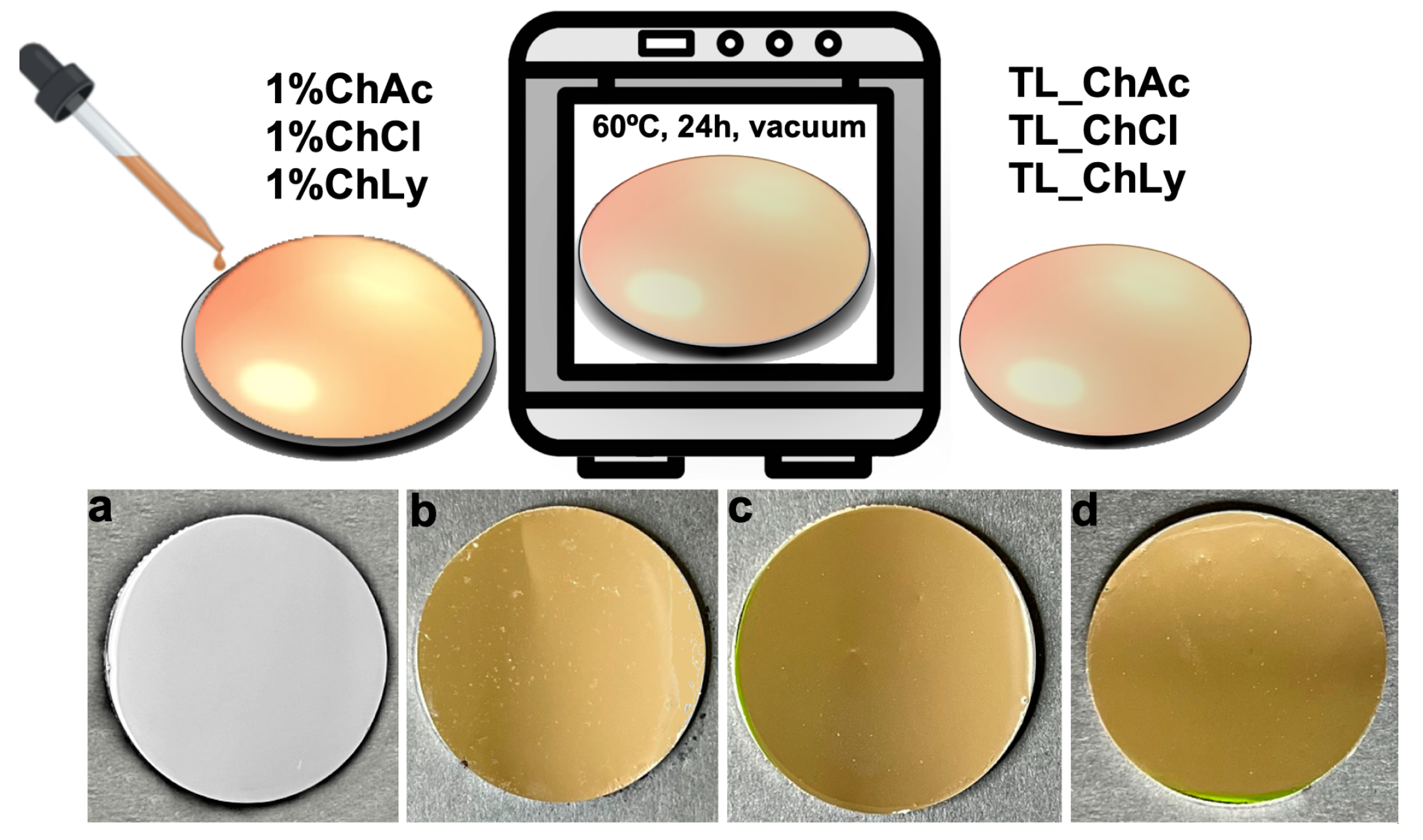

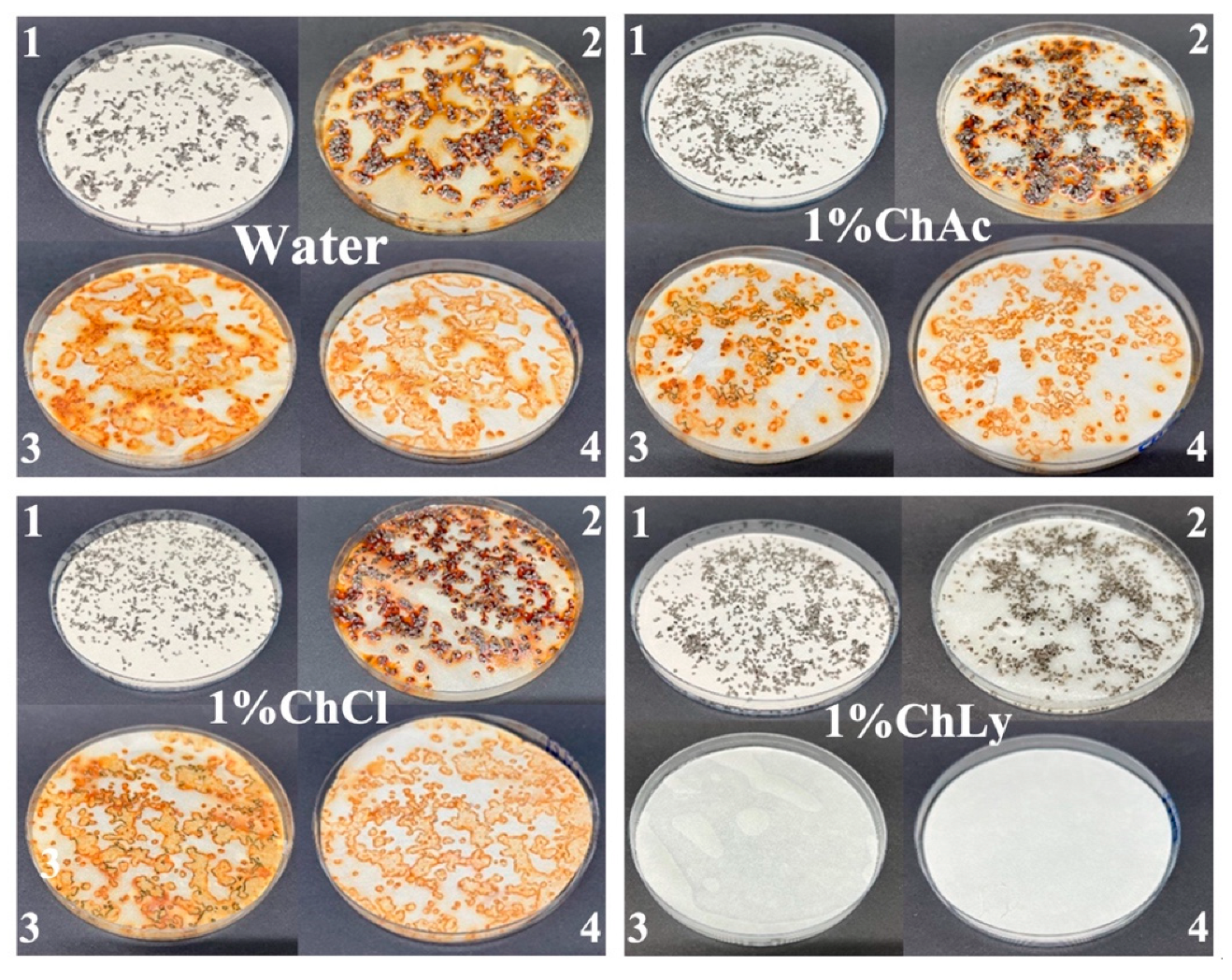
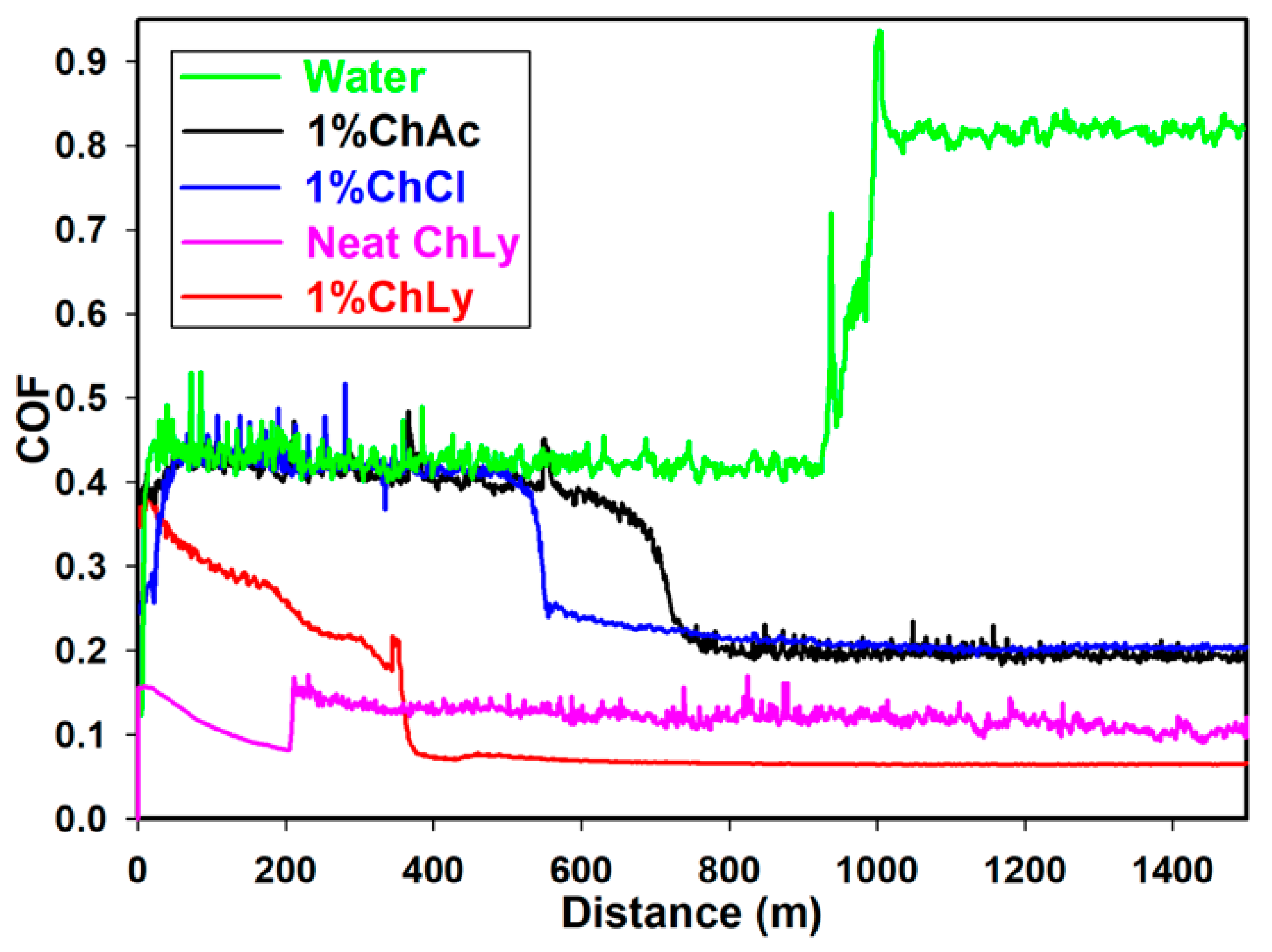


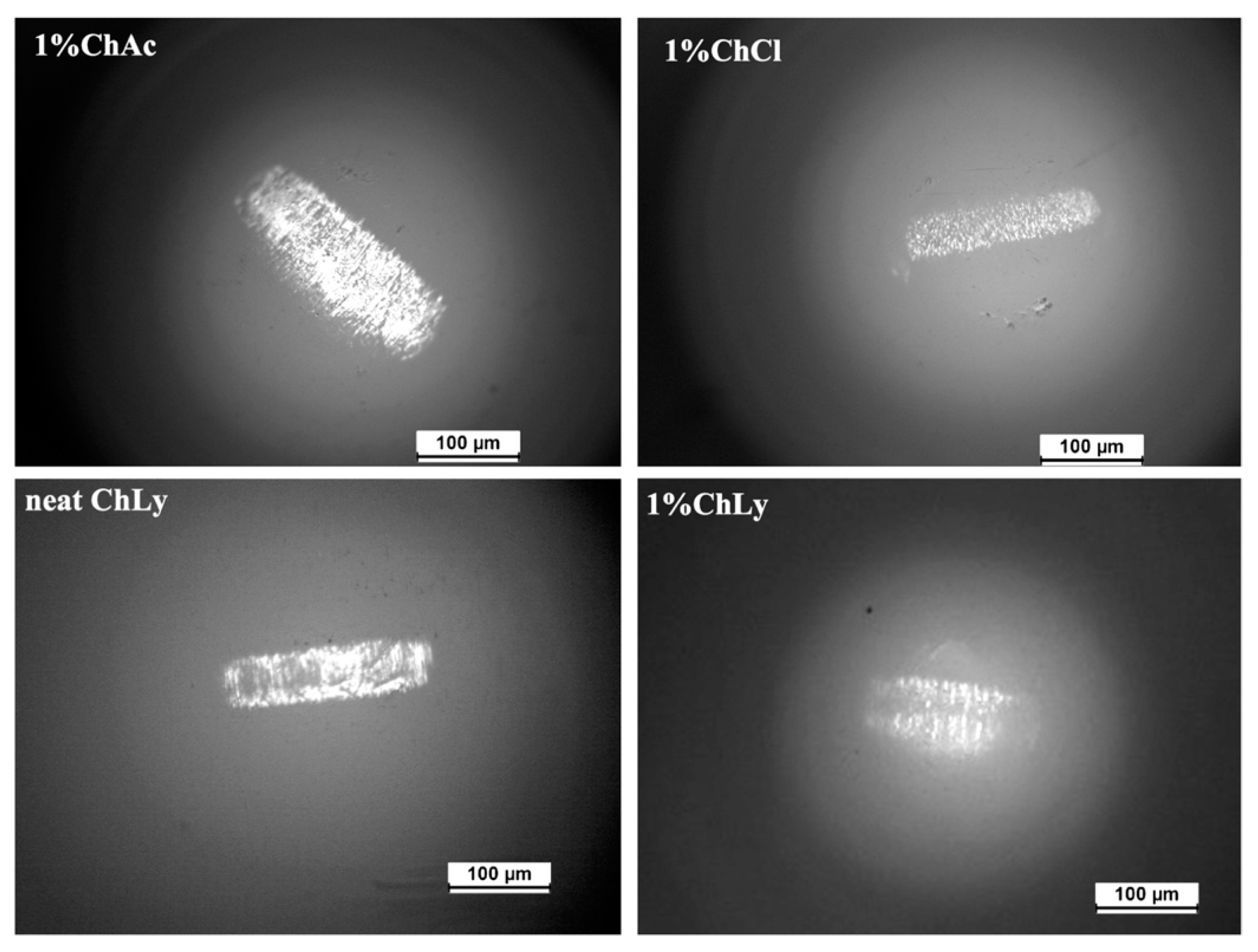

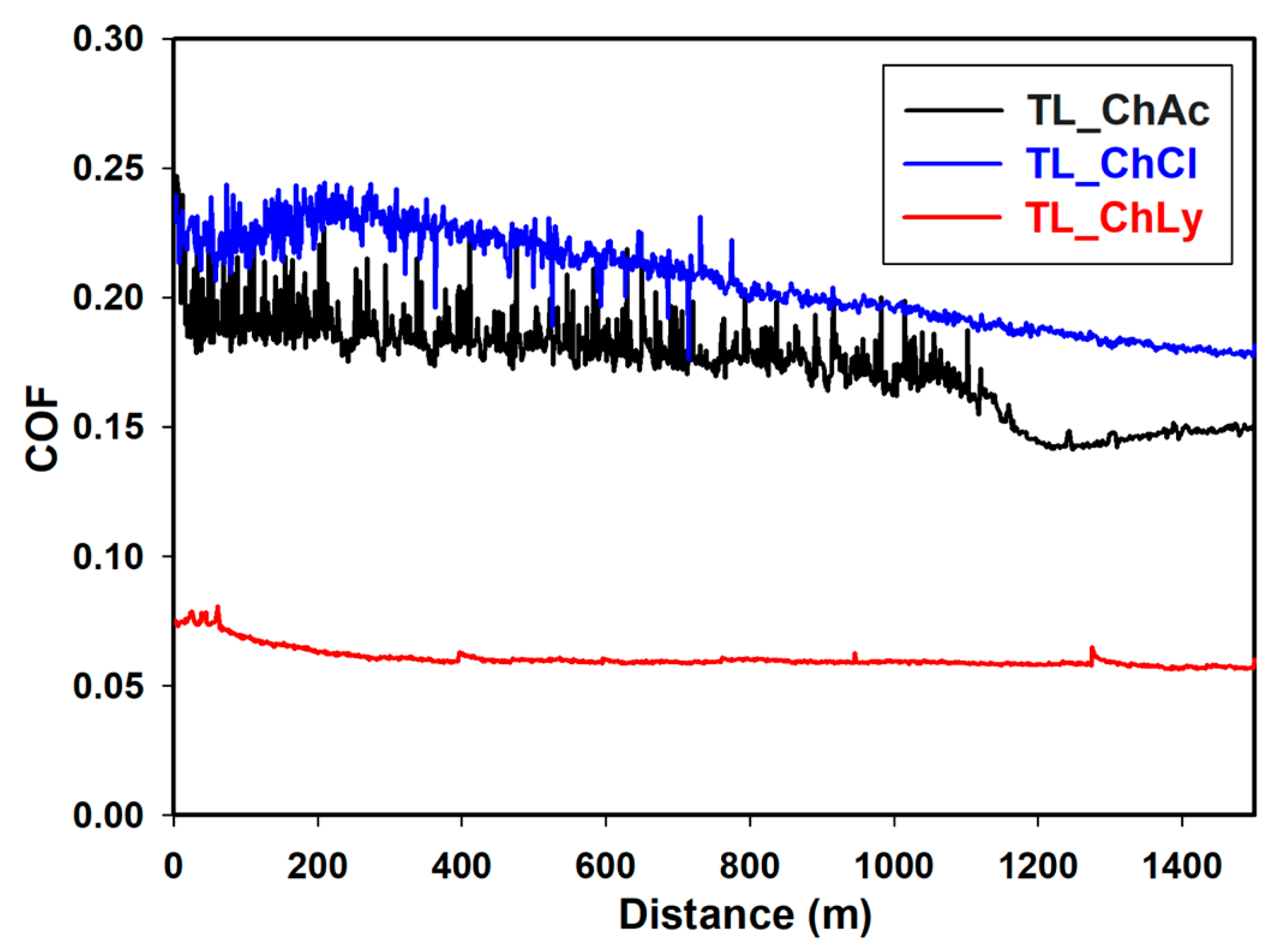

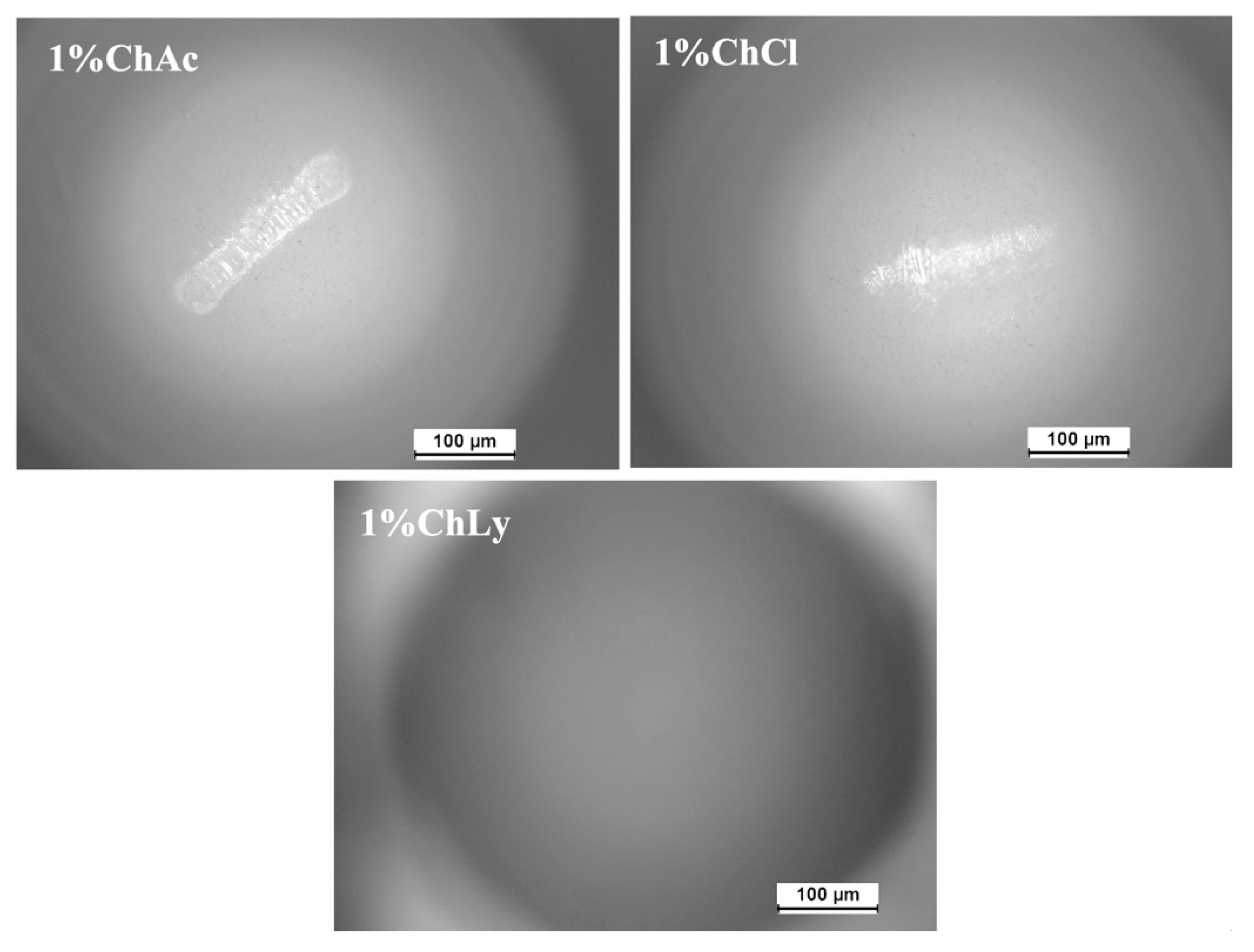
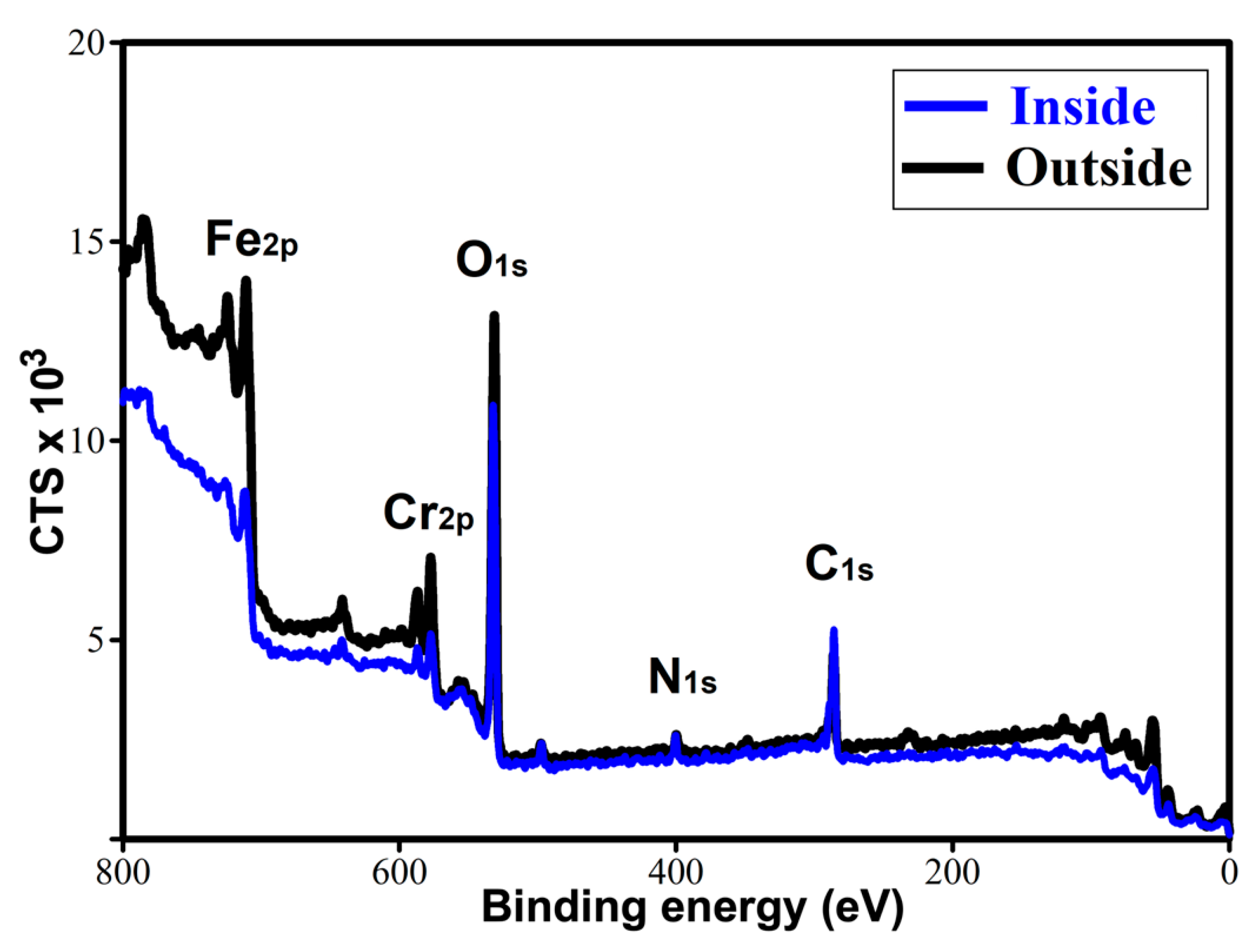
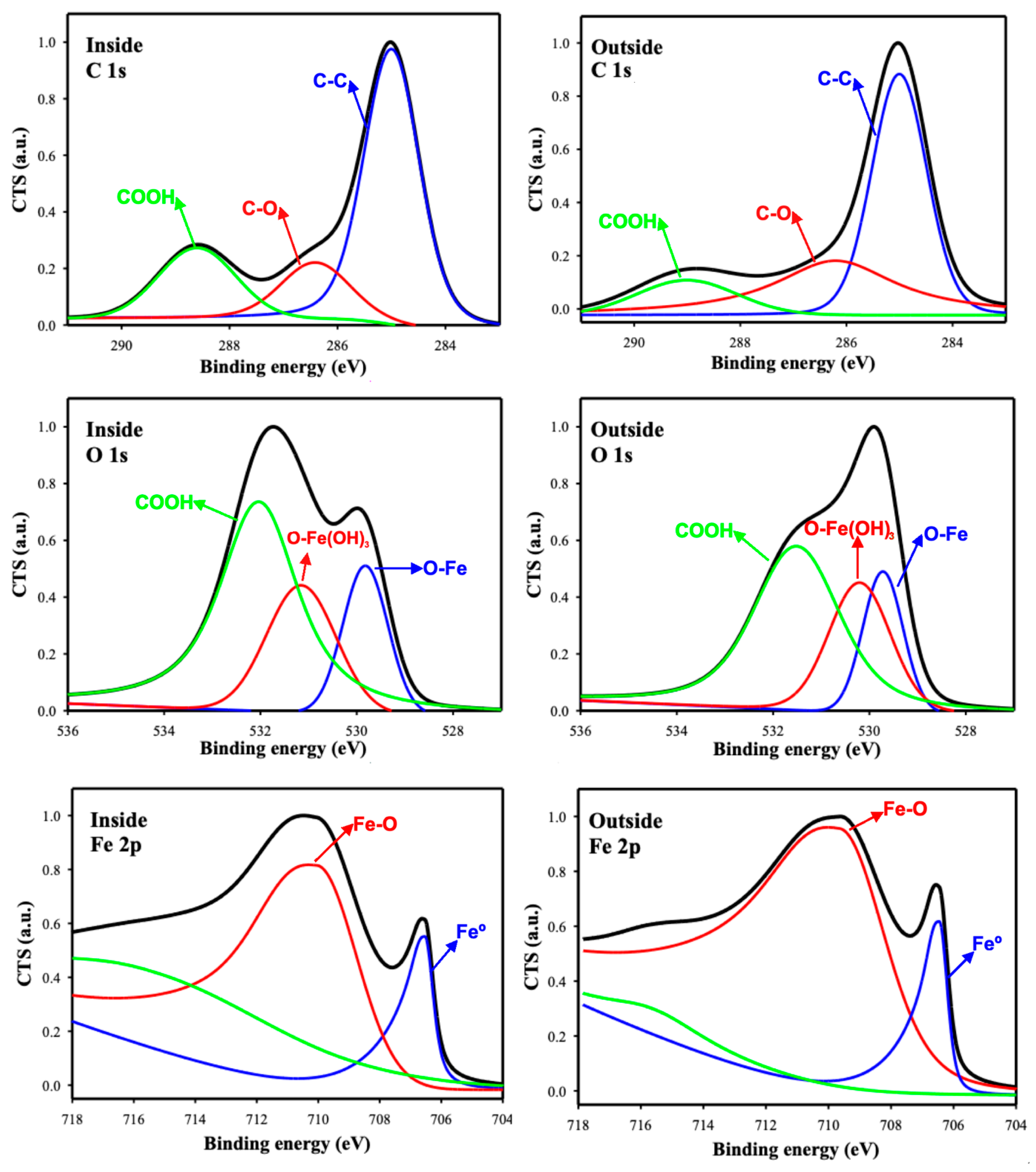
| 1%ChAc | 1%ChCl | 1%ChLy |
|---|---|---|
| 7.56 | 7.81 | 11.33 |
| Biolubricant | Initial | After 5 min |
|---|---|---|
| Water |  48.2 (±2.1) |  42.4 (±1.8) |
| Neat ChLy |  46.3 (±2.0) |  35.8 (±0.5) |
| 1%ChAc |  26.1 (±1.4) |  15.6 (±1.0) |
| 1%ChCl |  82.2 (±1.1) |  70.4 (±6.4) |
| 1%ChLy |  71.5 (±1.3) |  68.7 (±1.5) |
| Water-Based Biolubricants | Dynamic Viscosity (mPa·s) |
|---|---|
| 1%ChAc | 1.08 |
| 1%ChCl | 1.08 |
| 1%ChLy | 1.10 |
| Water-Based Biolubricants | Running-In Stage COF | Distance, m | Steady-State Stage COF |
|---|---|---|---|
| Water | 0.425 (±0.018) | 983 (±136) | 0.800 (±0.022) |
| 1%ChAc | 0.414 (±0.014) | 726 (±53) | 0.203 (±0.010) |
| 1%ChCl | 0.416 (±0.005) | 573 (±83) | 0.197 (±0.010) |
| Neat ChLy | 0.111 (±0.001) | 200 (±64) | 0.117 (±0.003) |
| 1%ChLy | 0.295 (±0.020) | 365 (±118) | 0.068 (±0.003) |
| Water | 1%ChAc | 1%ChCl | Neat ChLy | 1%ChLy |
|---|---|---|---|---|
| 3.98 × 10−5 | 3.12 × 10−5 | 1.62 × 10−5 | 1.51 × 10−5 | 9.65 × 10−7 |
| (±3.40 × 10−6) | (±2.37 × 10−6) | (±1.41 × 10−6) | (±1.22 × 10−6) | (±4.7 × 10−8) |
| Element | 1%ChAc | 1%ChCl | Neat ChLy | 1%ChLy | ||||
|---|---|---|---|---|---|---|---|---|
| Inside | Outside | Inside | Outside | Inside | Outside | Inside | Outside | |
| Fe | 60.85 | 64.05 | 53.73 | 64.76 | 65.73 | 65.21 | 64.43 | 65.75 |
| C | 4.74 | 3.88 | 8.74 | 3.92 | 3.86 | 4.39 | 4.1 | 3.75 |
| O | 4.76 | 1.51 | 3.39 | 1.90 | 0.41 | 0.51 | 2.53 | 0.39 |
| Cr | 15.24 | 16.35 | 12.22 | 15.14 | 16.64 | 16.49 | 16.17 | 16.61 |
| Ni | 8.90 | 7.30 | 16.81 | 8.08 | 9.52 | 9.61 | 9.16 | 9.62 |
| Mo | 1.93 | 2.28 | 1.68 | 2.08 | 1.91 | 1.87 | 1.59 | 1.67 |
| Thin-Layer Samples | Friction Coefficient (Standard Deviation) | K × 10−7, mm3/N·m (Standard Deviation) |
|---|---|---|
| TL_ChAc | 0.176 (±0.008) | 219 (±19.80) |
| TL_ChCl | 0.204 (±0.014) | 190 (±1.55) |
| TL_ChLy | 0.054 (±0.005) | 5.0 (±0.26) |
| Element | Inside (at %) | Outside (at %) |
|---|---|---|
| C 1s | 36.0 | 22.3 |
| O 1s | 42.7 | 45.0 |
| N 1s | 4.0 | 2.2 |
| Fe 2p | 13.0 | 23.1 |
| Cr 2p | 4.4 | 7.2 |
Disclaimer/Publisher’s Note: The statements, opinions and data contained in all publications are solely those of the individual author(s) and contributor(s) and not of MDPI and/or the editor(s). MDPI and/or the editor(s) disclaim responsibility for any injury to people or property resulting from any ideas, methods, instructions or products referred to in the content. |
© 2025 by the authors. Licensee MDPI, Basel, Switzerland. This article is an open access article distributed under the terms and conditions of the Creative Commons Attribution (CC BY) license (https://creativecommons.org/licenses/by/4.0/).
Share and Cite
Mostaza, P.; Avilés, M.-D.; Martínez-Rubio, P.M.; Bermúdez, M.-D.; Carrión-Vilches, F.J. Novel Water-Based Biolubricants Using Choline Ionic Liquids. Lubricants 2025, 13, 122. https://doi.org/10.3390/lubricants13030122
Mostaza P, Avilés M-D, Martínez-Rubio PM, Bermúdez M-D, Carrión-Vilches FJ. Novel Water-Based Biolubricants Using Choline Ionic Liquids. Lubricants. 2025; 13(3):122. https://doi.org/10.3390/lubricants13030122
Chicago/Turabian StyleMostaza, Paloma, María-Dolores Avilés, Pablo M. Martínez-Rubio, María-Dolores Bermúdez, and Francisco J. Carrión-Vilches. 2025. "Novel Water-Based Biolubricants Using Choline Ionic Liquids" Lubricants 13, no. 3: 122. https://doi.org/10.3390/lubricants13030122
APA StyleMostaza, P., Avilés, M.-D., Martínez-Rubio, P. M., Bermúdez, M.-D., & Carrión-Vilches, F. J. (2025). Novel Water-Based Biolubricants Using Choline Ionic Liquids. Lubricants, 13(3), 122. https://doi.org/10.3390/lubricants13030122







